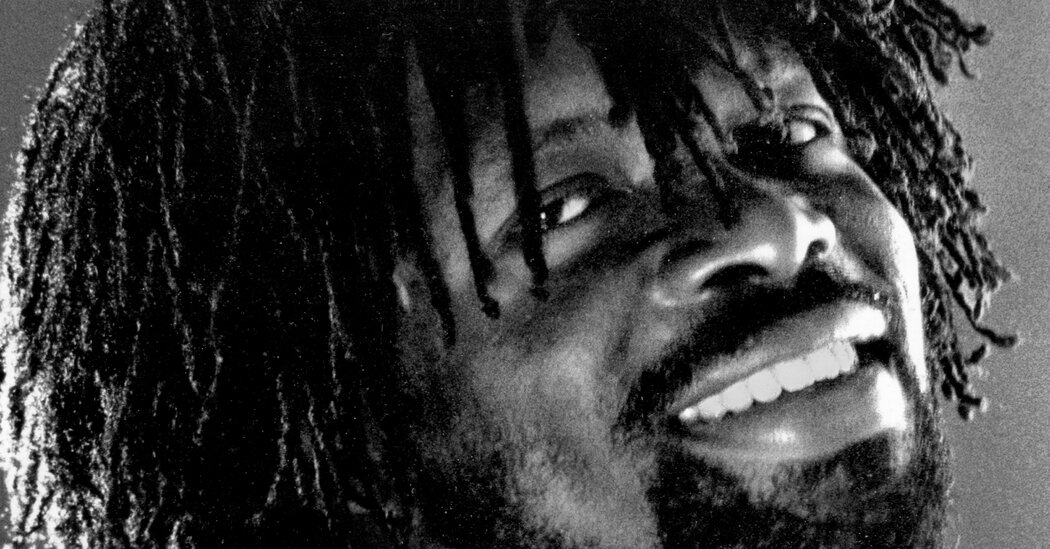This article is part of Overlooked, a series of obituaries about remarkable people whose deaths, beginning in 1851, went unreported in The Times.
In the photograph “Snap Shot,” soft light elegantly caresses an anonymous standing figure in a sensual pose. The figure, who is nude, holds a camera in front of his genitals with the lens pointed at the viewer. The image is striking in its careful balance between strength and fragility: The subject takes the risk of being seen while disrupting the viewer’s otherwise voyeuristic gaze.
In another photo, a man wearing a birdlike mask kneels and touches his head while his penis, painted gold, is accentuated by a glowing light.
Both images were created by the photographer Rotimi Fani-Kayode, and both were intended to celebrate and reclaim Black male sexuality in the 1980s. It was a time when renowned artists like Robert Mapplethorpe were building a narrative that fetishized Black men by reducing them to erotic objects devoid of individual identities, as noted by scholars like the feminist writer bell hooks. Instead, Rotimi Fani-Kayode placed Black men at the center of his images and presented them with emotional depth and a sensitive intimacy.
“I was used to seeing gay men in terms of popular culture, but they were always white gay men, while Black men were always seen in terms of fear and threat,” the British photographer Ajamu X said in an interview.
When he first saw Fani-Kayode’s work, he added: “I was blown away. He opened a portal, and I stepped through it.”
Fani-Kayode’s artistry was layered, based on his Yoruba culture, his displacement from his homeland, Nigeria, and his queerness; his work was infused with sexuality, race and rebellion. By intertwining these elements, he asserted the joyful, playful and mutually enriching coexistence of both queer and African identities — two forces that were often considered incompatible.
He explained his approach in a 1988 essay, “Rage & Desire”: “On three counts I am an outsider: in matters of sexuality, in terms of geographical and cultural dislocation and in the sense of not having become the sort of married professional my parents might have hoped for.”
He was born Oluwarotimi Adebiyi Wahab Fani-Kayode on April 20, 1955, in Lagos. His father, Victor Remilekun Fani-Kayode, was the high priest of Ife, a nearby city of ancestral importance in Yoruba culture. He was also a prominent politician: He played a key role in arguing for Nigeria’s independence from Britain in 1960 and became deputy prime minister of the country’s Western Region in 1964.
On Jan. 15, 1966, soldiers stormed into the family’s home at nightfall and ransacked it. They were part of the first of many coups in which young military officers would violently overthrow Nigeria’s democratic government as a means, in their view, of rooting out corruption.
“We were hidden in the wardrobe, and when the soldiers came, they wanted to shoot bullets into the wardrobe,” Fani-Kayode’s younger brother, Femi, said in a 2018 interview with the BBC.
Their mother, Adia Adunni Fani-Kayode, begged the soldiers to hold their fire. But they took her husband captive and detained him at an army barracks for six months. Rotimi, as he was called, was just 10 years old.
Once the elder Fani-Kayode was released, the family fled to the United Kingdom, where he had connections. They settled in Brighton, in the south of England, where Rotimi and his siblings attended elite schools.
Rotimi Fani-Kayode moved to the United States in 1976 and graduated from Georgetown University in 1980 with a degree in economics and fine art. He then earned an M.A. at the Pratt Institute in New York, where he trained under Mapplethorpe. He also discovered in the city a Black gay community in which he could express his sexuality. (He nods to that community in the dedication of his first monograph, “Black Male/White Male,” published in 1987.)
Fani-Kayode moved back to England in 1983 and immersed himself in his photography, creating some of the most striking work of his career in his home studio in Brixton, in South London.
Brixton was an energetic hub of artistic creativity during a tumultuous period when social and cultural movements were challenging both the arts and the political establishments, notably in the 1981 Brixton uprising, in which young, Black and mostly working-class Londoners clashed with the Metropolitan Police to protest racist policing.
Artistically, comparisons have been drawn between Brixton in the 1980s and the Harlem Renaissance of the 1920s.
Fani-Kayode became a familiar sight around town, usually wearing a white shirt, leather trousers, boots and round rimmed glasses. “He had this confidence, and he was a fine and sexy brother,” Ajamu X, who lived in the same housing cooperative as Fani-Kayode and modeled for his photographs, said in the interview.
Fani-Kayode often created self-portraits, many of which were printed in black and white in part to keep costs down. In “Umbrella” (1987), he poses nude and cross-legged while looking up, his face hidden by a white umbrella, whose ribs stretch beyond the edges of the frame. A slight blur of his left foot suggests movement, yet his knuckles, clasped around the umbrella’s handle, indicate firm conviction.
Many of his images incorporate his Yoruba culture, usually through the use of masks.
“I try to bring out the spiritual dimension in my pictures so that concepts of reality become ambiguous and are opened to reinterpretation,” he wrote in “Rage & Desire.” “This requires what Yoruba priests and artists call a ‘technique of ecstasy.’”
His work was exhibited in only one solo show during his lifetime, in London, but it appeared in several group exhibitions.
Fani-Kayode was one of the original signatories of Autograph, an agency, gallery and archive that was founded in London in 1988 by the Association of Black Photographers; its stated mission: “to champion the work of artists who use photography and film to highlight questions of race, representation, human rights and social justice.” He was its first chair.
“Autograph is forged in riot,” said Mark Sealy, who has been the organization’s director since 1991. He added, “What we represent is a resistance to the status quo, and Rotimi was part of that.”
A key relationship in Fani-Kayode’s push against norms was with Alex Hirst, an artist and an editor at the gay magazine Square Peg, a quarterly published from 1983 to 1992. They were romantic partners and creative collaborators, living, working and navigating the art world from the time they met, in 1983.
In their artistic work — they made several photographs together — and in their union as a mixed-race couple (Hirst was white), the two refused to recognize boundaries of race, culture and class. “I don’t think Rotimi’s work was ever just about cultural or sexual identity or oppression,” Hirst said in the 1991 documentary “Rage & Desire,” named after Fani-Kayode’s essay.
Though Fani-Kayode created a substantial body of work, his career — which included publishing photos in Gay Times magazine and the African contemporary arts magazine Revue Noire — lasted just six years. He died of AIDS-related complications on Dec. 21, 1989, in a hospital in North London. He was 34.
Fani-Kayode did not leave a will, and his final series of color photographs, posthumously titled “Communion,” was curated by Sealy and exhibited in 1995 in York, in the north of England, and then in London four years later. The series included “The Golden Phallus” as well as imagery that referenced classical religious iconography and the symbolism of flowers.
Hirst, who died in 1992, entrusted Autograph with Fani-Kayode’s archive of work, and it has been recognized nationally and internationally, including in a major retrospective at the Autograph gallery and another at the Wexner Center for the Arts in Columbus, Ohio. A new monograph of Fani-Kayode’s work is expected to be published in 2026, Sealy said.
Traces of Fani-Kayode’s influence can be seen in other photographers’ work, including Zanele Muholi in South Africa, Eric Gyamfi in Ghana and Paul Mpagi Sepuya in Los Angeles.
“Rotimi Fani-Kayode is, for me, part of a constituency of historically important figures who take the camera as a lens of liberation that they offer on the world,” Sealy said. “They’re not necessarily about photography; they’re about that lens. They’re about a way of seeing.”
In his own words, Fani-Kayode saw photography as an essential tool with which to express himself: “It is photography, therefore — Black, African, homosexual photography — that I must use not just as an instrument, but as a weapon if I am to resist attacks on my integrity and, indeed, my existence on my own terms.”
The post Overlooked No More: Rotimi Fani-Kayode, Whose Camera Sought a Truer Image of Black Men appeared first on New York Times.




